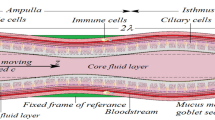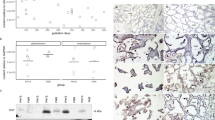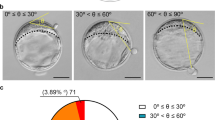Abstract
IT takes about 3 to 4 days for eggs to reach the uterus after oestrus in most mammals, regardless of the length of the tubes1. In the rabbit the transport of eggs through the ampulla to the isthmus of the tube takes only a few minutes2,3, but 3–4 days4–6 are required for transport to the uterus. The eggs do not seem to be transported at the same speed during their passage through the whole tube, but they stop in the isthmus or in the uterine tubal junction and await some action of the tube which will transport them into the uterus.
This is a preview of subscription content, access via your institution
Access options
Subscribe to this journal
Receive 51 print issues and online access
$199.00 per year
only $3.90 per issue
Buy this article
- Purchase on Springer Link
- Instant access to full article PDF
Prices may be subject to local taxes which are calculated during checkout
Similar content being viewed by others
References
Hartman, C. G., Science and the Safe Period, 78 (Williams and Wilkins, 1962).
Harper, M. J. K., Proc. Fourth Intern. Congr. Anim. Reprod. The Hague, 375 (1961).
Harper, M. J. K., Endocr., 77, 114 (1965).
Gregory, P. W., Contrib. to Embryol., 21, 141 (1930).
Pincus, G., Proc. Roy. Soc., B, 107, 132 (1930).
Chang, M. C., and Harper, M. J. K., Endocr., 78, 860 (1966).
Novak, E., and Everett, H. S., Amer. J. Obstet. Gynec., 16, 499 (1928).
Wislocki, G. B., and Snyder, F. F., Bull. Johns Hopkins Hosp., 52, 379 (1933).
Black, D. L., and Asdell, S. A., Amer. J. Physiol., 192, 63 (1958).
Greenwald, G. S., Fertil. and Steril., 12, 80 (1961).
Dowling, D. F., J. Agr. Sci., 39, 374 (1949).
Pomeroy, R. W., J. Agr. Sci., 45, 327 (1955).
Wintenberger, S., Brebis, Ann. Zootech., 2, 269 (1953).
Marden, W. G. R., Endocr., 50, 456 (1952).
Burdick, H. D., and Pincus, G., Amer. J. Physiol., 111, 201 (1935).
Whitney, R., and Burdick, H. O., Endocr., 20, 643 (1936).
Pincus, G., and Kirsch, R. E., Amer. J. Physiol., 155, 219 (1936).
Greenwald, G. S., J. Endocr., 26, 133 (1963).
Rowson, L. E., J. Endocr., 7, 260 (1951).
Chang, M. C., and Yanagimachi, R., Fertil. and Steril., 16, 281 (1965).
Chang, M. C., Endocr., 79, 949 (1966).
Chang, M. C., J. Gen. Physiol., 30, 321 (1947).
Chang, M. C., J. Exp. Zool., 114, 197 (1950).
Author information
Authors and Affiliations
Rights and permissions
About this article
Cite this article
CHANG, M. Transport of Eggs from the Fallopian Tube to the Uterus as a Function of Oestrogen. Nature 212, 1048–1049 (1966). https://doi.org/10.1038/2121048b0
Issue Date:
DOI: https://doi.org/10.1038/2121048b0
This article is cited by
-
Immunohistochemical localization of estrogen receptor alpha (ERα) in the oviduct of Indian buffalo during follicular and luteal phases of estrous cycle
Tropical Animal Health and Production (2019)
Comments
By submitting a comment you agree to abide by our Terms and Community Guidelines. If you find something abusive or that does not comply with our terms or guidelines please flag it as inappropriate.



